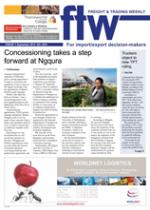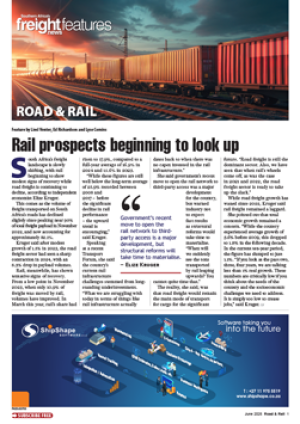Maersk Line has put a
complete stop to further
investment in its reefer
(refrigerated container)
division.
In an exclusive interview
on a trip to SA, Thomas
Eskesen, senior director of
reefer management for the
AP Moller Maersk Group,
told FTW that the return on
reefer investment was no
longer sufficient.
“The good news is that
there has been a significant
demand for reefer
transportation,” he said.
“The bad news is that the
investment needed to meet
the gap between supply and
demand is high.
“So Maersk has decided
to stop our investment
in new reefer equipment
for 2013 because it’s so
capital-intensive.”
And the figures for
this investment give a
good idea of why Eskesen
describes it as so. The AP
Moller Group has cancelled
planned investments of
US$500 million in new
equipment for 2013, and
US$1.7 billion was the
total investment cost in
2012 just to maintain the
existing reefer fleet.
In a communiqué to
customers, the line said:
“We are at a cross-roads.
Cost saving and process
improvements can no
longer provide for an
acceptable return.
“Continued investment in
reefer is our preferred path,
but current returns do not
support this path. Investing
in reefer equipment must
be financially sustainable.”
Eskesen followed a
similar train of thought
when he told FTW: “The
outlook is not particularly
bright. So it’s got to
the point now where us
investing such a large
amount is not justified.
“It’s such desperate times
– that’s the main point.
Due to substantial losses
we felt that we should not
invest any more.”
With Maersk having
a reefer market share
in excess of 20%, this
restriction in acquiring
new equipment is going to
lead to a supply/demand
gap in the market.
On its own estimates,
if Maersk Line does not
recommence investment,
global reefer container
demand will outstrip
supply by 9% by 2015.
What’s going to fill this
gap?
Not the conventional
reefer vessels, Eskesen
reckoned, adding that
they won’t fill the supply/
demand gap as they are
scrapping significant
capacity.
The conventional vessel
reduction of 8.5% from
2011 tonnage was the
highest seen to date (as at
July 2012), he told FTW.
Also, this year some 59 of
688 vessels were scrapped
to date, and this could
reach 100 vessels by end-
2012.
The conventional
fleet is growing older
as no new investment
in vessels is planned.
Also, the scrapping of
younger vessels results in
a significant reduction of
shipping supply for the
reefer market.
And the latest trends also
indicate that increasing
preference for reefer
containers is rapidly
pushing conventional
reefers out of the
perishable trade.
According to Eskesen,
70% of the reefer market
is now containerised,
although this figure differs
market to market. In SA,
for example, the 2010 split
was 80% containerised
to 20% conventional –
and in 2011 this number
had increased to 84%
containerised and 16%
conventional, according
to the information that the
Perishable Products Export
Control Board (PPECB)
circulates.
“Also,” Eskesen
added, “global volume of
containerised reefer traffic
is increasing at a fairly
healthy percentage of at
least 5% a year.”
So the end conclusion
to all this is that there will
either be an unbridgeable
supply/demand gap, or
other major lines are going
to have to take on the very
financially risky path of
massive investments in
their reefer trades.
CAPTION
Thomas Eskesen … ‘Investing
such a large amount is not
justified.’

